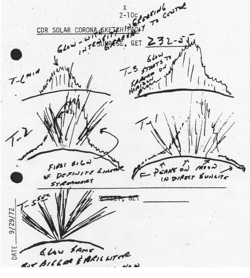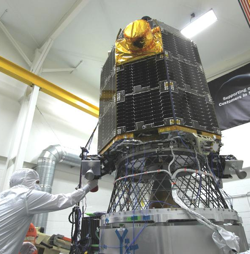As a long-time Space Nerd trying to manage her expectations, it’s easy for me to settle into a cocoon of pessimism when it comes to the prospect of boots on the surface of the moon and Mars. After all, no concrete plans for a crewed mission beyond low Earth orbit are in the pipeline—we’re still in the early stages of rebuilding our manned spaceflight infrastructure, and the maiden un-crewed flight of the new heavy-lift “Space Launch System” isn’t slated until 2017. And yet, quietly and with little fanfare, NASA is inching its way toward our return to the moon one tiny satellite at a time.
The latest of which is LADEE—the Lunar Atmosphere and Dust Environment Explorer—set to launch between August and October of 2013. It’s a smallish, unassuming satellite, weighing only 383 kg and standing just under two meters tall. But it has more than its share of jobs to do in the 130 days between its arrival in lunar orbit and its scheduled crash landing on the moon’s surface.
Job One: An Atmospheric Investigation
As the name “Lunar Atmosphere and Dust Environment Explorer” suggests, LADEE’s primary science goal is to study the moon’s atmosphere: how its composition and distribution changes over time, how much dust it contains (if any), and how it interacts with the lunar surface. So of course, my first reaction to the mission profile was a raised eyebrow, as I’d been under the impression that the moon didn’t have an atmosphere to begin with.
As it turns out, it kind of doesn’t. The volume of space surrounding the moon is more accurately described as an “exosphere,” which we think is generated by a combination of solar wind and outgassing. Mostly made up of argon and helium, this wisp of particles is so insubstantial that it’s functionally a vacuum, composed of about a hundred molecules per cubic centimeter (as opposed to the 1020 molecules in every cubic centimeter of the air you’re breathing now.) Because it’s so low-density, molecules almost never collide with each other, moving instead along the parabolic arcs of ballistic trajectories. And because the majority of the exosphere is generated by solar wind, during the lunar night the bulk of it drifts back down to the surface.
 LADEE is also equipped with a specialized dust detector (Lunar Dust Experiment, or LDEX) to settle what appears to be a fairly controversial question: whether there’s dust in the exosphere as well. The current theory is that it contains some amount of electrostatically levitated dust, produced when ultraviolet light knocks electrons off particles of lunar soil and gives them an electric charge. It’s possible that the “tail” of Earth’s magnetic field, which the moon sweeps through in its orbit, can send these charged particles whole kilometers off the surface. The dust-in-the-exosphere theory is based in part on observations by the Apollo astronauts, who described a glow on the horizon after sunset and rays of light at twilight. However, those same astronauts also described flat rocks with completely bare surfaces, which some argue rules out the possibility of sunlight-levitated dust floating around.
LADEE is also equipped with a specialized dust detector (Lunar Dust Experiment, or LDEX) to settle what appears to be a fairly controversial question: whether there’s dust in the exosphere as well. The current theory is that it contains some amount of electrostatically levitated dust, produced when ultraviolet light knocks electrons off particles of lunar soil and gives them an electric charge. It’s possible that the “tail” of Earth’s magnetic field, which the moon sweeps through in its orbit, can send these charged particles whole kilometers off the surface. The dust-in-the-exosphere theory is based in part on observations by the Apollo astronauts, who described a glow on the horizon after sunset and rays of light at twilight. However, those same astronauts also described flat rocks with completely bare surfaces, which some argue rules out the possibility of sunlight-levitated dust floating around.
In 2007, the “Scientific Context for Exploration of the Moon” report from the National Research Council identified studies of the “pristine” lunar atmosphere as a leading priority for future missions. Because the exosphere is so fragile, there’s real danger that extensive robotic or human activity on the surface could permanently alter it.
Job Two: The Model T of Satellites
Physically, LADEE isn’t much to look at—a squat, bullet-shaped body covered in solar arrays, with the nozzle of a rocket engine sticking out the back end. The design feels generic and unremarkable, and that’s actually deliberate. LADEE is a proof-of-concept of sorts, the first satellite to use a new system of standardized modules as a base on which to build a specialized spacecraft.
 In 2006, the Small Spacecraft Office at NASA’s Ames Research Center began developing a “Modular Common Bus,” a basic spacecraft which could be adapted for a variety of space and surface missions. The goal of the program is to reduce the time and financial investment necessary to build small satellites and landers, ideally lowering the cost of a satellite to $150 million or less, not including science payloads (LADEE, by comparison, will cost about $263 million.) The default MCB includes body-mounted solar cells, avionics and a communications system to control the spacecraft and link it to the ground, and a standard fuel/oxidizer propulsion system. One of the reasons for long spacecraft development times is the extensive testing needed to find out if various systems are “space rated,” so in addition to an overall attempt to avoid unnecessary complexity, the MCB uses as many tried-and-true components as possible (note: as I discovered while researching this post, a history of real-world use in space is called “flight heritage,” a term which I find completely charming.)
In 2006, the Small Spacecraft Office at NASA’s Ames Research Center began developing a “Modular Common Bus,” a basic spacecraft which could be adapted for a variety of space and surface missions. The goal of the program is to reduce the time and financial investment necessary to build small satellites and landers, ideally lowering the cost of a satellite to $150 million or less, not including science payloads (LADEE, by comparison, will cost about $263 million.) The default MCB includes body-mounted solar cells, avionics and a communications system to control the spacecraft and link it to the ground, and a standard fuel/oxidizer propulsion system. One of the reasons for long spacecraft development times is the extensive testing needed to find out if various systems are “space rated,” so in addition to an overall attempt to avoid unnecessary complexity, the MCB uses as many tried-and-true components as possible (note: as I discovered while researching this post, a history of real-world use in space is called “flight heritage,” a term which I find completely charming.)
Faster, cheaper satellite development means a larger number of flight opportunities for science instruments and technical demonstrations, which can sometimes languish for years before they manage to find a ride into space. Which brings me to….
Job Three: Lasers Calling
There are some significant drawbacks to radio-based communications, including slow transfer rates and a limited number of frequencies set aside for NASA’s use. One proposed solution to these problems is lasercomm—literally, laser-based Earth-to-space communications. The Lunar Laser Communications Demonstration, designed and built by the MIT Lincoln Laboratory and NASA Goddard Space Flight Center, will transmit and receive optical signals between lunar orbit and a Lunar Laser Ground Terminal in White Sands, NM. Lasercomm is subject to the whims of local weather, and LLCD has to aim for Earth within 1º of accuracy, but the hope is that it’ll be capable of transmitting 622 megabits per second, about five times the rate currently possible from that distance.
The LLCD has waited years for this ride—it was originally the MLCD, with a spot reserved on the Mars Telecommunications Orbiter that was scrapped in 2005. Other lasercomm demonstrations—like the Optical PAyload for Lasercomm Science (OPALS), set to launch to the ISS aboard a SpaceX resupply mission in July—are between the ground and spacecraft in orbit. But the LLCD will be the first to try for an optical link at so great a distance, offering a hint at whether live video feeds from deep space are something we can realistically hope for.
LADEE and its payloads are already assembled and midway through testing, with the mechanical tests simulating launch stresses passed earlier this month, and an appointment to be baked and frozen in a vacuum chamber on its agenda for Spring. Barring any last-minute disasters, it’ll launch from the Wallops Flight Facility at NASA Goddard, riding aboard the brand-new, never-launched-a-satellite-before Minotaur V rocket.
As if this octagonal barrel of a satellite didn’t have enough firsts to deal with already.
~~~
Sources and further reading:
LADEE Mission Page and News @ NASA
LADEE Mission Outline @ NASA Science
Multi-Mission Suitability of the NASA Ames MCB @ NASATRS (PDF)
LADEE Mission Outline @ NASATRS (PDF)
The Lunar Laser Communications Demonstration Project @ MIT’s Dspace
NASA Mission to Study the Moon’s Fragile Atmosphere @ NASA Science
LADEE Spacecraft Details @ National Space Science Data Center
Minotaur V Fact Sheet @ Orbital (PDF)
Alison Wilgus spends most of her time making comics and the rest of it thinking about space. Recently she’s written a SF novella about Mars and drawn an interactive webcomic about a cat, firmly planting her flags at either end of the nerd spectrum.









